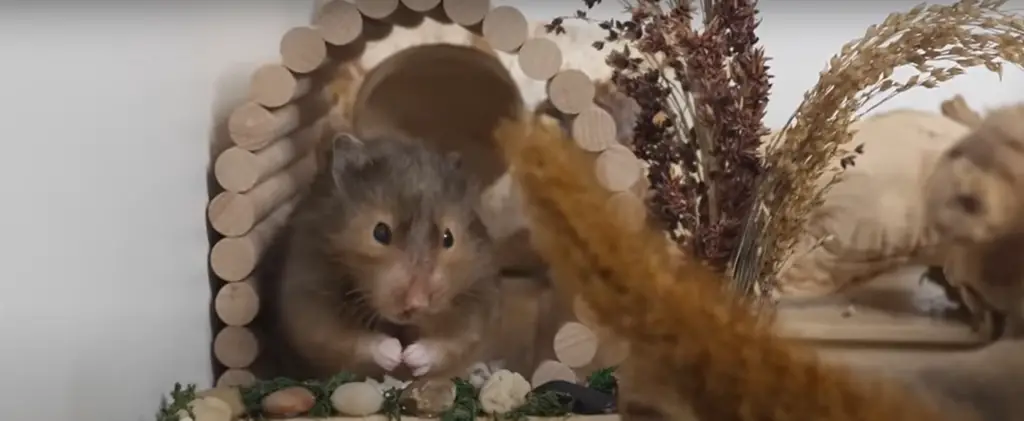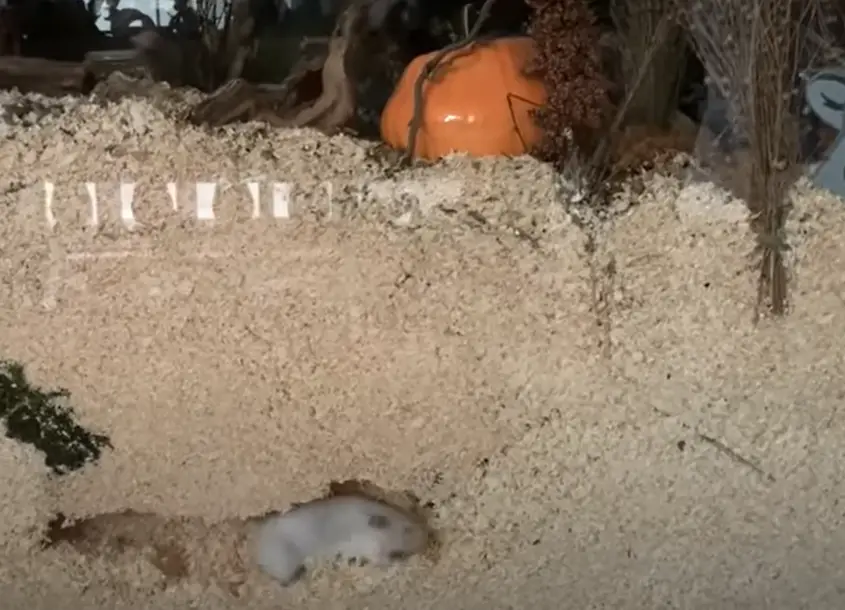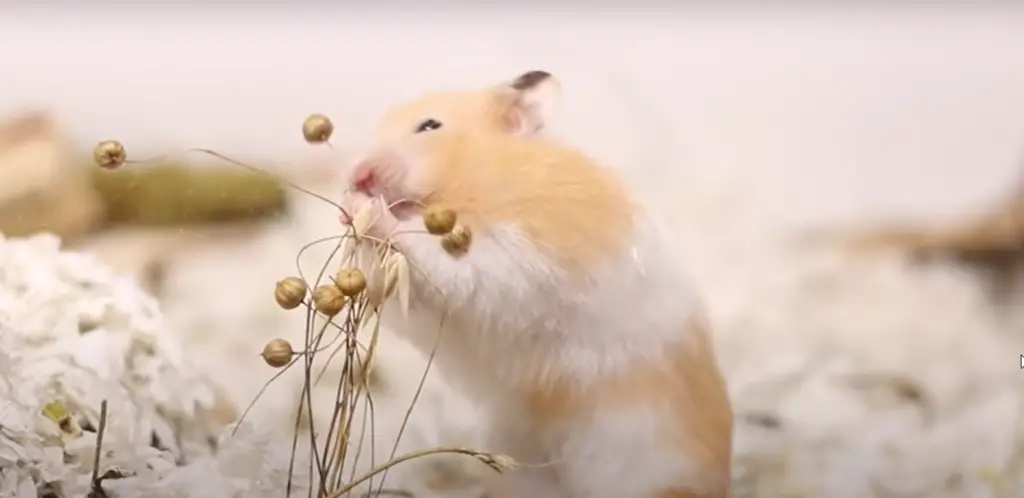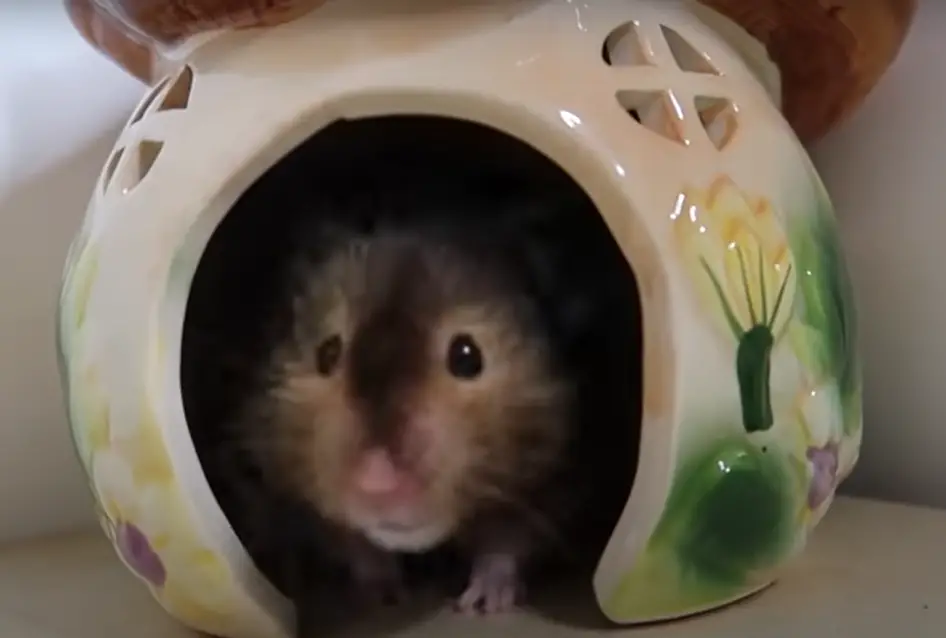- What does hamster enrichment mean?
- What kind of enrichment are hamsters interested in?
- 1- Enrichment with Forage and Sprays
- 2- The Bedding Enrichment
- 3- The Sandbath is an excellent enrichment for a hamster
- 4- Enrichment for hamsters with branches
- 5-Platforms and hideouts as enrichment for hamsters:
- Final Thoughts
The enrichment that hamsters need must stimulate them physically and mentally, and what interests and stimulates them must certainly be related to the food, smells, and textures they feel under their paws. So if you want to encourage your hamster to be active and avoid boredom, give him enrichments and boredom breakers that have as their ultimate goal treats, seeds, and nuts.
What does hamster enrichment mean?
Enrichment for a pet in captivity is to provide him with ways to stimulate him mentally and physically to make his life in a cage or in a free-range pen, much longer and less boring, and to provide him with better mental and physical well-being.
There are several types of enrichment for pets:
Food-based enrichment means stimulating the animal to use its food by encouraging it to search for food and earn rewards such as treats.
Sensory stimulation, by providing scents, etc. to stimulate the animal’s 5 senses, sight, smell, touch, hearing, and taste.
Physical stimulation, by offering physical enrichment such as toys, climbing things, etc.
Social stimulation and enrichment, by providing the pet with a companion or interaction with you or any other animal.
What kind of enrichment are hamsters interested in?

Hamsters are really only interested in food, and that should be the basis of any enrichment you provide.
To keep your hamster from getting bored, you’ll need to stimulate it to run, search and think, and the only way to keep a hamster positively occupied is when it wins food at the end.
Your hamster will do anything for a few extra seeds to take back to his nest to increase his stock; this is what stimulates them in their natural habitat, they spend all night foraging and collecting food and bedding and nesting materials, and taking all this back to their burrow.
They also spend some time cleaning themselves and taking sand baths.
The best ways to provide enrichment for your hamster:
1- Enrichment with Forage and Sprays
Forage as enrichment for hamsters
If you want an easy way to stimulate your hamster mentally and physically, just use his own food, making him search for it in his enclosure and earn it instead of just serving it to him in his food bowl.
This hamster enrichment is the best of all, easy to provide; here’s how to create enrichment for your hamster using his food:
Sprinkle and scatter his dry food around his cage, this will encourage your hamster to seek it out, using his well-developed sense of smell to find every seed and food.
You will then scatter his dry food, seeds, dried herbs, leaves, and flowers all over his cage, except in the spots and corners he uses to urinate, also avoid putting it on his wheel.
This will also create new smells in the cage and not only the smell of the bedding and his urine, this is what will stimulate his sense of smell too.
Fresh food and veggies, you should not hide them in his bedding to avoid mold, you can create skewers with pieces of vegetables and peanuts, for example, you will then hang these skewers to create an occupation for your hamster and encourage him to go up and eat them.
Sprays as enrichment for hamsters :
These are plant pods that still contain their seeds; you will plant these dry stems in the bedding of the hamster and encourage him to pick his own seeds directly from this stem and it is an excellent enrichment.
You can use several plants for this, here are the most known sprays in the hamster parent community:
- Unflavored Millet Sprays ( Yellow and Mohair )
- Oat Sprays
- Pagima Green Sprays
- Amaranth Spray
- Flax Sprays ( only one stem per week )
- Black or white Sorghum Sprays
- Quinoa Sprays
- Wheat Spray
Many of these sprays are only available on the internet, you have to bring them from outside the USA.
2- The Bedding Enrichment
The thickness and quality of the bedding
There is a direct relationship between the thickness and quality of your hamster’s bedding and its stress level.
I recommend beddings that support the construction of tunnels and underground chambers, your hamster will stop digging if the bedding collapses on him and his tunnels collapse too.
Opt for paper-based bedding and do not forget to compact it well to make it more stable.
You can also reinforce the Hemp shavings, Aspen bedding or carefresh with fine hay, this will make them denser and your hamster’s tunnels will not collapse as easily.
In addition to this, the thicker the bedding, the less stressed your hamster will be. Hamsters normally live underground, digging tunnels and chambers to a depth of 30 inches (90 cm).
The best enrichment for your hamster after its food is to provide a good thickness of bedding, at least 15 inches (38 cm).
The thicker the bedding, the happier your hamster will be and the less stress and bar biting it will cause.
Your hamster may not dig his own tunnels and this enrichment will be unsuccessful, so you will have to encourage your hamster to dig, especially a dwarf hamster, who likes to find ready-made tunnels and they will just occupy them.
You can use artificial tunnels such as hay cardboard tunnels (bury it in the bedding and leave only the tunnel entrance visible) or cork logs to create the tunnel entrance and encourage your hamster to continue digging by himself.
You will never know when your hamster will start tunneling and digging his chambers in the bedding, just prepare his enclosure with a good thickness of bedding and let him decide when he will start digging.
Varying the substrates is an enrichment for the hamster as well
To stimulate your hamster, you can also reserve 20% of the enclosure surface and use other substrates, healthy of course, to change a bit from paper-based bedding.
Your hamster will love to feel other textures under his paws than paper, he will love to walk on sand and take his baths, dig (natural instinct that you will satisfy by installing a Dig box as enrichment too).
You can delimit a space in the hamster’s enclosure and use different substrates like :
- Coconut Fiber
- Pillow and Sphagnum Moss
- Kaytee Corn cob bedding (if your hamster does not eat it)
- Cork Granules
- Beech Chips
3- The Sandbath is an excellent enrichment for a hamster
The sandbox is a large container ( use a baking dish ) that you will fill with safe soft sand like chinchillas ( if it is not dusty ) or soft reptile sand ( without additives ) or use children’s play sand ( avoid dirt, dust, and powders ), a good thickness, and that your hamster will use as a bathroom.
The sandbox is an excellent enrichment that will not only keep your hamster busy as they clean themselves and take several sand baths a day, but it will also keep them clean and get rid of excess oil that could clutter their fur.
Don’t forget to install a small hideout in a corner of your hamster’s sandbath, it will give him more confidence and a sense of security.
4- Enrichment for hamsters with branches
The other way to provide enrichment for the hamster is to provide it with tunnels, tubes like the cork log whose diameter exceeds 2 inches for dwarf hamsters and at least 3 inches in diameter for Syrians (the same measurements for hideout entrances), and branches in order to mimic as much as possible its natural habitat.
This enrichment will also provide places to hide and feel safe, obstacles to cross, and another texture to walk on (wood) …
Use natural materials like cork, bamboo roots, birch, and terracotta tubes, or fine wood, your hamster will probably chew them to wear down his teeth and scratch them to wear down his nails.
5-Platforms and hideouts as enrichment for hamsters:
You can use a wooden tray to place on your hamster’s bedding and then place some seeds on it, the hamster wheel, etc. without the risk of it falling on your hamster if he tunnels under it.
The hideouts are a necessary enrichment for the hamster, he uses them to hide when he feels threatened or stressed, he can also take his naps in a hideout and it is often the entrance of the tunnels that your hamsters will dig, these tunnels often end up in one of the hideouts, which will actually play the role of subway stations.
Hamsters hate open spaces, it makes them anxious because there is always a risk that they will be attacked by a raptor when they are in the wild.
This fear is natural and you should provide your hamster with plenty of hideouts, choose different materials, terracotta clay, wood, cardboard, ceramic, etc.
Also, install at least one multi-chamber hideout in the enclosure and then place a few smaller ones in other corners.
Make sure that the entrances of the hideouts are wide enough to avoid hurting your hamster when it has jowls full of seeds.
Final Thoughts
Hamsters need enrichment to make them forget their confinement in an enclosure. Your hamster will need a lot of enrichment, especially when left alone for more than two days.
Start by getting him a large enclosure, at least 1000 square inches, then get him a layer of at least 15 inches of paper-based bedding.
Then add hideouts, a wheel, hideouts, a sandbox, and lots of toys and chews.
Don’t forget to scatter his food around to stimulate his sense of smell, and to provide him with sprays to trigger his natural foraging instinct.
All of this is the minimum you can do to keep your hamster from getting bored in his enclosure and to make life in captivity more bearable for him, remember that hamsters normally need a territory of hundreds of square inches.
Images source: Victoria Raechel’s YouTube Channel






